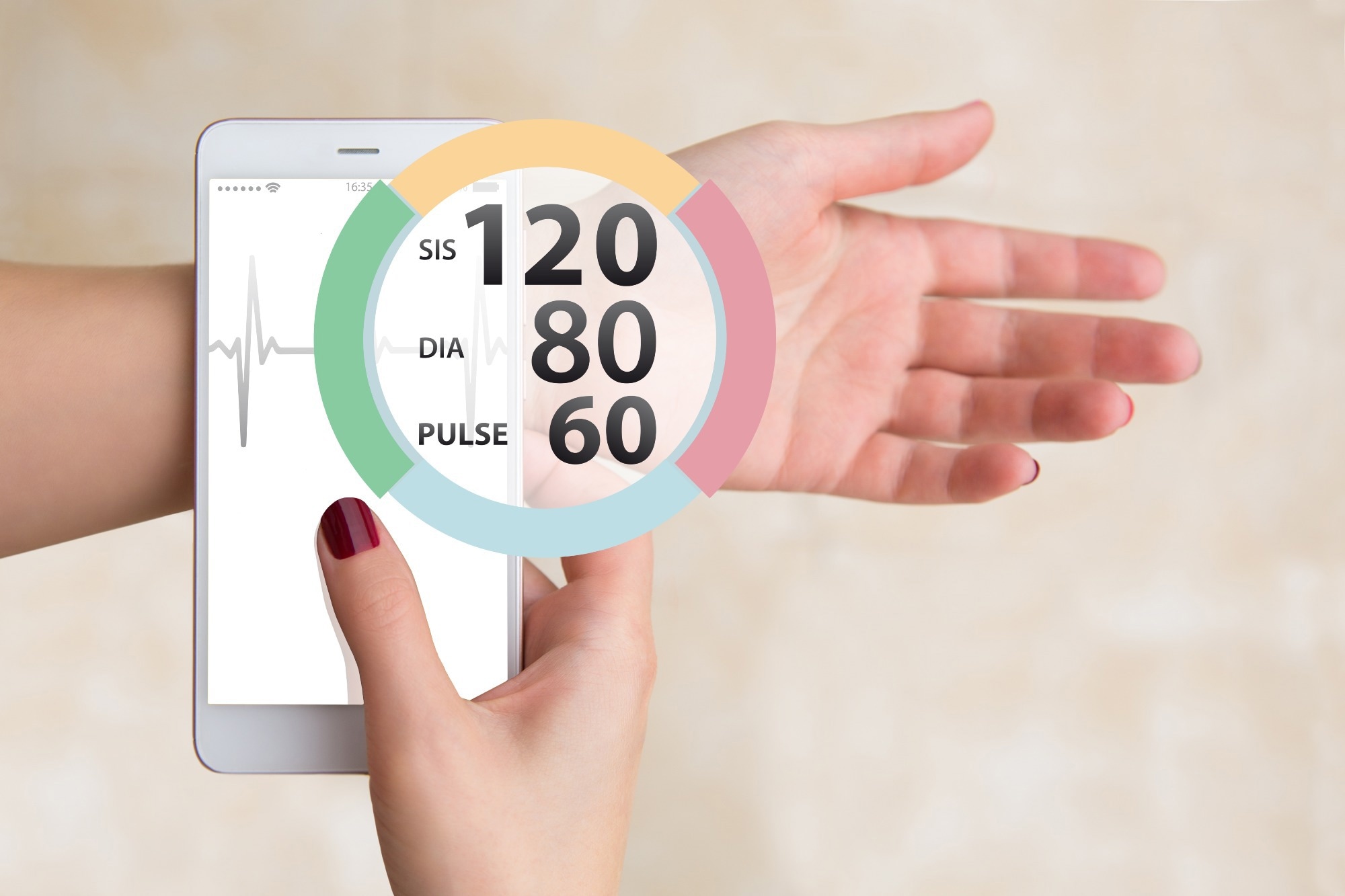Researchers validated a novel wearable ultrasound blood pressure (BP) sensor, confirming its accuracy and safety across diverse clinical settings. This non-invasive sensor offers continuous, reliable BP monitoring, maintaining calibration for up to one year and adapting to various patient conditions.
 Study: Clinical validation of a wearable ultrasound sensor of blood pressure. Image Credit: Scarfsinn / Shutterstock.com
Study: Clinical validation of a wearable ultrasound sensor of blood pressure. Image Credit: Scarfsinn / Shutterstock.com
A recent study published in the journal Nature Biomedical Engineering discusses the results of validation studies assessing the accuracy of a novel wearable blood pressure (BP) sensor in clinical settings.
Current methods for BP measurement
The sphygmomanometer, the most frequently used tool to measure BP, uses an inflatable upper arm cuff and measures BP over the brachial artery. This tool provides separate measurements for diastolic and systolic BP that are isolated from each other by the time needed for each inflation-deflation cycle.
Continuous BP assessment currently relies on the use of an arterial line (A-line). However, this method is often painful and invasive, limiting its use to critical care patients.
Other techniques, like photoplethysmography, depend on local blood volume changes that are correlated with BP. This method is confined to capillaries less than eight millimeters (mm) deep, and the observed changes are significantly different from those in the brachial artery.
Recent advances in BP sensors
Wearable mechanical sensors are non-invasive, as they detect skin deflections caused by pulsations in the underlying peripheral arteries that can be translated into BP readings. However, the precision of these measurements can be affected by skin characteristics, including elasticity and subcutaneous fat, as well as external temperature and humidity.
Comparatively, wearable ultrasound sensors can pass through tissue to considerable depths without significant signal weakening. High-frequency ultrasound devices achieve high resolution, thus accurately identifying arterial pulsations rather than skin deflections.
These sensors can provide continuous BP monitoring in a non-invasive manner. However, inaccuracies may arise due to the use of isolated acoustic windows, which can introduce measurement errors. Furthermore, the safety and performance of wearable ultrasound BP sensors have not been fully validated.
About the study
The current study used rigorous criteria to validate measurements obtained from a completely redesigned wearable ultrasound BP sensor. This sensor was tested in various settings, including in-home, outpatient clinics, a cardiac catheterization laboratory, and intensive care units (ICUs).
The study’s aim was to assess the ability of this sensor to be used safely and reliably, providing results meeting the highest clinical standards.
Rethinking sensor design
The brachial and radial arteries, commonly used to measure the BP, are only two to five mm wide and between three and 20 mm deep, with relatively stiff walls, unlike the large and flexible central arteries.
The transducer was redesigned with a closely arranged sensor array of low pitch, thereby providing a 10 mm acoustic window rather than separate windows. This avoids the risk of misalignment-induced inaccuracy and ensures complete coverage of the vessel.
The transducer offers superior accuracy and consistency of measurement due to the presence of a 500 μm thick backing layer. This layer minimizes excessive vibrations of the activated transducer, thereby reducing the length of received radiofrequency pulses and promoting the accurate detection of wall pulsations, even from stiff peripheral arteries.
This sensor has excellent wearability, as it is only about 800 micrometers (μm) thick and adapts to skin characteristics. Moreover, the sensor is highly durable and can be sterilized, thus making it suitable for long-term monitoring.
The newly developed sensor complies with the United States Food and Drug Administration (FDA) Track 1 safety recommendations for diagnostic ultrasound devices. Moreover, it can be used for prolonged periods, as it does not cause adverse biological effects due to heating. A one-year comparative study of the sensor confirmed its ability to maintain accurate calibration for this period.
Validation studies
The sensor accurately monitored BP changes in a home setting with position, posture, exercise, relaxation, and biochemical shifts due to caffeine or food consumption. The results agreed with those obtained by sphygmomanometry in both amplitude and direction of change at 95.8% concordance for systolic BP (SBP), 98.5% for mean arterial pressure (MAP), and 93.2% for diastolic BP (DBP).
In the outpatient clinic, similarly high concordance was observed with interventions aimed at causing BP fluctuations by change of posture. However, larger differences were observed between readings in the standing position, which may be attributed to several patients with neurologic disease that can cause orthostatic hypotension. Sphygmomanometer error due to the constant fluctuation with postural change may have also contributed to these differences.
The cardiac catheterization laboratory uses A-lines to monitor BP changes in response to sedation, vascular relaxation, blood loss, and changes in the cardiac output. In this setting, measurements obtained from the ultrasound sensors were not significantly different from those obtained with A-lines. The waveform from the brachial artery similarly exhibited a high linear correlation with A-line tracings from central arteries.
Sensor and A-line readings obtained in the ICU setting similarly showed strong agreement.
The significance
Non-invasive continuous BP measurements can identify small variations that may reflect increased cardiovascular disease (CVD) risk, including paroxysmal hypertension, autonomic dysfunction, or nocturnal hypertension.
The continuous use of this device in multiple situations and contexts minimized white-coat hypertension and the confounding effects of daily activities and medications on BP readings. These factors are often ignored during the development of such prototypes.
Conclusions
The study findings validate the accuracy of a wearable ultrasound BP sensor using a rigorous and comprehensive clinical protocol. Its safety and excellent performance were confirmed when compared to both commonly used sphygmomanometer measurements and A-lines, the latter of which are the gold standard for continuous BP measurement.
The sensor is convenient and robust for daily activities, can maintain calibration for at least one year, and is not affected by skin characteristics. Moreover, it effectively monitored BP changes for 12 hours in the ICU.
These collective features suggest that the ultrasound sensor is accurate and reliable for eventual at-home use and common clinical settings.”
Additional studies are needed to identify any alterations in BP measurements with arterial wall responses to cardiac arrhythmia. The potential need for recalibration, when used in severely ill patients with significant hemodynamic instability, should also be assessed.
Reproducibility between operators should be ensured before the industrialization of this device. Increased power efficiency and automated integration of the device with hospital information systems would help upload BP data without delay or loss of accuracy.
Journal reference:
- Zhou, S., Park, G., Longardner, K., et al. (2024). Clinical validation of a wearable ultrasound sensor of blood pressure. Nature Biomedical Engineering. doi:10.1038/s41551-024-01279-3.




